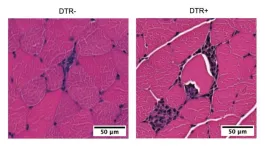(Press-News.org) Researchers at Weill Cornell Medicine have led a phase 1 trial of a new drug that delivers potent radiation therapy directly and specifically to cancer cells in patients with advanced prostate cancer. The clinical trial showed that the “radiopharmaceutical” was well tolerated and demonstrated promising antitumor activity, according to a new study published on Nov. 2 in the Journal of Clinical Oncology.
The radiopharmaceutical 225AC-J591 was administered in a single injection and consists of two parts: an antibody that helps find the cancer cells is linked to a molecule that delivers a deadly dose of radiation. Specifically, an antibody named J591 that targets a protein found on the surface of most prostate cancer cells called prostate-specific membrane antigen (PSMA), is linked to the radioactive isotope actinium-225, which emits high-energy alpha particles to destroy cancer cells. Dr. Neil Bander, professor emeritus of urology at Weill Cornell Medicine, developed J591 in 1996. This antibody targets prostate cancer cells anywhere in the body while avoiding healthy tissues and organs.
“Despite considerable advances to improve prostate cancer survival, there is no cure yet for metastatic prostate cancer,” said lead author and principal investigator of the trial Dr. Scott Tagawa, a professor of medicine and medicine in urology at Weill Cornell Medicine and medical director of the genitourinary oncology program at NewYork-Presbyterian/Weill Cornell Medical Center. “Our results from this first-in-human study of a PSMA-targeted alpha emitter are very exciting and a testament to more than two decades of translational research at Weill Cornell Medicine.”
Prostate cancer is the second most common cause of death due to cancer in men in the United States. For those whose cancer has spread (metastasized) to other areas of the body and does not respond to therapies that lower testosterone, the five-year survival rate is 34 percent, according to the American Cancer Society.
Advantages of Using a Drug that Emits Alpha Particles
Previously, scientists at Weill Cornell Medicine radiolabeled J591 with beta particle emitters, such as lutetium-177 (177Lu). In previous phase 1 and 2 studies, 177Lu-J591 effectively targeted metastatic sites with acceptable toxicity and showed encouraging signs of response and improvements in overall survival.
Dr. Bander’s lab has also investigated J591 attached to another molecule called actinium which emits alpha particles. “Actinium is about four thousand times more potent and has a shorter delivery range than lutetium, delivering more energy to kill cancer cells with less harm to surrounding healthy tissue,” Dr. Tagawa said.
With the need for more treatment options, Dr. Tagawa conducted the phase 1 study of 225Ac-J591 between October 2017 and January 2021 at Weill Cornell Medicine and Tulane University School of Medicine. A total of 32 patients with metastatic prostate cancer received a single injection of the radiopharmaceutical: 22 patients received one of seven escalating dose levels, and then 10 patients in the expansion group received the highest dose.
Promising Phase 1 Trial Results
The researchers found 225AC-J591 had good antitumor activity against advanced metastatic prostate cancer and was well tolerated. Prostate-specific antigen (PSA)—an indication of cancer severity—decreased by at least half for 47 percent of patients. In addition, 13 of 22 (59 percent) patients experienced a drop in circulating tumor count. These results are encouraging signs that the treatment was working to destroy prostate cancer cells.
Most high-grade adverse events involved low blood cell counts, and all were temporary. As the highest dose level of 225Ac-J591 that could be given without severe side effects was not reached and only one dose was administered in the phase 1 trial, a follow-up combined phase 1/phase 2 study is now underway. The new study will further assess its safety and efficacy with split or multiple infusions at higher cumulative doses.
“These strong results are due to the multidisciplinary collaboration between medical oncologists and our nuclear medicine group,” said Dr. Tagawa, co-leader of the Experimental Therapeutics Program at the Sandra and Edward Meyer Cancer Center and a member of the Englander Institute of Precision Medicine. “We look forward to continuing to advance 225Ac-J591 in a combined phase 1/phase 2 follow-up study and future trials. If successful, 225Ac-J591 may offer new hope for patients with metastatic prostate cancer.”
Cornell University has exclusively licensed this technology to Convergent Therapeutics, Inc., a clinical stage pharmaceutical company focused on developing next-generation radiopharmaceutical therapies for prostate and other cancers. Convergent is one of many startups launched with foundational technology developed at Weill Cornell Medicine. The office of Enterprise Innovation, which accelerates the translation of scientific discoveries into medical breakthroughs, played a crucial role in the licensing of this technology to Convergent.
The study was supported by funding from Weill Cornell Medicine philanthropic donors, a Prostate Cancer Foundation Challenge Award, and grants from the National Institutes of Health (Weill Cornell Medicine Prostate Cancer SPORE Developmental Research Project 1P50CA211024-01 and ULI RR024996) and the U.S. Department of Defense (W81XWH-17-PCRP-IA).
Many Weill Cornell Medicine physicians and scientists maintain relationships and collaborate with external organizations to foster scientific innovation and provide expert guidance. The institution makes these disclosures public to ensure transparency. For this information, see the profiles for Dr. Scott Tagawa and Dr. Neil Bander.
END
New radiopharmaceutical shows antitumor activity in patients with advanced prostate cancer
2023-11-03
ELSE PRESS RELEASES FROM THIS DATE:
U of M-led study identifies new pathway to combat primary cause of cardiovascular disease
2023-11-03
MINNEAPOLIS/ST. PAUL (11/03/2023) — Research led by the University of Minnesota Medical School identified a new pathway to combat cardiovascular disease. The study was recently published in Nature Cardiovascular Research.
The research team’s work identifies a molecule called TREM2 as a unique and therapeutically relevant pathway for the treatment of atherosclerosis—a common condition that develops when plaque builds up inside arteries—in preclinical models. Atherosclerosis is a primary cause of cardiovascular diseases, which are the number one ...
Illinois Tech grows research footprint, securing prime space at TCC’s Fulton Labs
2023-11-03
CHICAGO—November 3, 2023—Illinois Institute of Technology (Illinois Tech) has leased approximately 34,295 square feet in Trammell Crow Company’s (TCC) Fulton Labs innovation hub, announced today by the Chicago office of TCC, a global real estate developer. Illinois Tech will occupy the entire 7th floor of the cutting-edge wet lab facilities at 400 North Aberdeen, aiming to fuel scientific breakthroughs and industry-relevant research as the first academic institution to join the thriving and collaborative innovation ecosystem alongside their Fulton Labs neighbors, which include Portal Innovations and the Chan Zuckerberg BioHub. ...
Physicists ask: Can we make a particle collider more energy efficient?
2023-11-03
Ever since the discovery of the Higgs boson in 2012, physicists have wanted to build new particle colliders to better understand the properties of that elusive particle and probe elementary particle physics at ever-higher energy scales.
The trick is, doing so takes energy – a lot of it. A typical collider takes hundreds of megawatts – the equivalent of tens of millions of modern lightbulbs – to operate. That's to say nothing of the energy it takes to build the devices, and it all adds ...
Study shows that smoking ‘stops’ cancer-fighting proteins, causing cancer and making it harder to treat
2023-11-03
November 3, TORONTO — Scientists at the Ontario Institute for Cancer Research (OICR) have uncovered one way tobacco smoking causes cancer and makes it harder to treat by undermining the body’s anti-cancer safeguards.
Their new study, published today in Science Advances, links tobacco smoking to harmful changes in DNA called ‘stop-gain mutations’ that tell the body to stop making certain proteins before they are fully formed.
They found that these stop-gain mutations were especially prevalent in genes known as ‘tumour-suppressors’, ...
How salt from the Caribbean affects our climate
2023-11-03
Joint press release by MARUM - Center for Marine Environmental Sciences at the University of Bremen and GEOMAR Helmholtz Centre for Ocean Research Kiel
The distribution of salt by ocean currents plays a crucial role in regulating the global climate. This is what researchers from Dalhousie University in Canada, GEOMAR Helmholtz Centre for Ocean Research Kiel, Alfred Wegener Institute, Helmholtz Centre for Polar and Marine Research (AWI) and MARUM – Center for Marine Environmental Sciences at the University of Bremen have found in a new study. ...
Some benefits of exercise stem from the immune system
2023-11-03
The connection between exercise and inflammation has captivated the imagination of researchers ever since an early 20th-century study showed a spike of white cells in the blood of Boston marathon runners following the race.
Now, a new Harvard Medical School study published Nov. 3 in Science Immunology may offer a molecular explanation behind this century-old observation.
The study, done in mice, suggests that the beneficial effects of exercise may be driven, at least partly, by the immune system. It shows that muscle inflammation caused by exertion mobilizes inflammation-countering T cells, or Tregs, which enhance the muscles’ ability to use ...
Seeing the unseen: How butterflies can help scientists detect cancer
2023-11-03
There are many creatures on our planet with more advanced senses than humans. Turtles can sense Earth’s magnetic field. Mantis shrimp can detect polarized light. Elephants can hear much lower frequencies than humans can. Butterflies can perceive a broader range of colors, including ultraviolet (UV) light.
Inspired by the enhanced visual system of the Papilio xuthus butterfly, a team of researchers have developed an imaging sensor capable of “seeing” into the UV range inaccessible to human eyes. The design of the sensor uses stacked photodiodes and perovskite nanocrystals (PNCs) capable of imaging different wavelengths ...
nTIDE October 2023 Jobs Report: People with disabilities maintain job gains as economy cools
2023-11-03
East Hanover, NJ – November 3, 2023 – Experts reported little change in October’s employment indicators, as people with disabilities extended their historic highs into the fall, according to today’s National Trends in Disability Employment (nTIDE) – semi-monthly update issued by Kessler Foundation and the University of New Hampshire’s Institute on Disability (UNH-IOD). As anti-inflationary measures exert their cooling effects on the economy, people with disabilities are striving to maintain their gains in the post-pandemic labor market.
Month-to-Month nTIDE Numbers (comparing September 2023 to October 2023)
Based on ...
Large herbivores such as elephants, bison and moose contribute to tree diversity
2023-11-03
Using global satellite data, a research team has mapped the tree cover of the world’s protected areas. The study shows that regions with abundant large herbivores in many settings have a more variable tree cover, which is expected to benefit biodiversity overall.
Maintaining species-rich and resilient ecosystems is key to preserving biodiversity and mitigating climate change. Here, megafauna – the part of the animal population in an area that is made up of the largest animals – plays an important role. In a new study published in the scientific journal One Earth, an international research team, of which Lund University is a part, has investigated the intricate interplay ...
The kids aren't alright: Saplings reveal how changing climate may undermine forests
2023-11-03
As climate scientist Don Falk was hiking through a forest, the old, green pines stretched overhead. But he had the feeling that something was missing. Then his eyes found it: a seedling, brittle and brown, overlooked because of its lifelessness. Once Falk's eyes found one, the others quickly fell into his awareness. An entire generation of young trees had died.
Falk – a professor in the UArizona School of Natural Resources and the Environment, with joint appointments in the Laboratory ...





